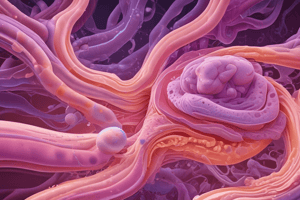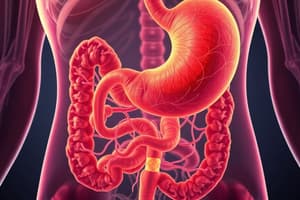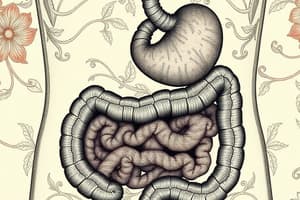Podcast
Questions and Answers
What primarily determines the contraction rhythm in smooth muscle?
What primarily determines the contraction rhythm in smooth muscle?
- Frequency of slow waves (correct)
- Calcium influx
- Frequency of Na+ influx
- Spike potentials
What does the application of ACh cause in gastric muscle cells when drug X is present?
What does the application of ACh cause in gastric muscle cells when drug X is present?
- Membrane action potentials and Ca2+ changes (correct)
- Hyperpolarization of the membrane
- Relaxation of muscle cells
- Increased muscle contraction
What is the role of the myenteric plexus in the gastrointestinal tract?
What is the role of the myenteric plexus in the gastrointestinal tract?
- Connects to the autonomic nervous system
- Controls GIT movements (correct)
- Regulates blood flow
- Controls gastrointestinal secretion
Which neurotransmitter is released from intrinsic nerves in the intestine to cause muscle contraction?
Which neurotransmitter is released from intrinsic nerves in the intestine to cause muscle contraction?
What effect does sympathetic nervous system stimulation have on gastrointestinal activity?
What effect does sympathetic nervous system stimulation have on gastrointestinal activity?
What is the primary function of the submucosal plexus in the enteric nervous system?
What is the primary function of the submucosal plexus in the enteric nervous system?
Which of the following does not result from slow waves in smooth muscle cells?
Which of the following does not result from slow waves in smooth muscle cells?
What is the effect of excessive gut distention on intestinal movements?
What is the effect of excessive gut distention on intestinal movements?
What is the primary function of the gastrocolic reflex?
What is the primary function of the gastrocolic reflex?
Which hormone is primarily responsible for stimulating gastric acid secretion?
Which hormone is primarily responsible for stimulating gastric acid secretion?
What triggers the release of cholecystokinin (CCK)?
What triggers the release of cholecystokinin (CCK)?
Which reflex is responsible for inhibiting stomach motility and secretion?
Which reflex is responsible for inhibiting stomach motility and secretion?
What role does somatostatin play in the gastrointestinal system?
What role does somatostatin play in the gastrointestinal system?
What is the function of the vagovagal reflex?
What is the function of the vagovagal reflex?
Which sensation primarily initiates the vomiting reflex?
Which sensation primarily initiates the vomiting reflex?
What is the main purpose of cholecystokinin (CCK) in digestion?
What is the main purpose of cholecystokinin (CCK) in digestion?
What is the role of interstitial cells of Cajal in the gastrointestinal tract?
What is the role of interstitial cells of Cajal in the gastrointestinal tract?
Which layer of the gastrointestinal wall extends longitudinally down the intestinal tract?
Which layer of the gastrointestinal wall extends longitudinally down the intestinal tract?
What distinguishes slow waves from spike potentials in gastrointestinal smooth muscle?
What distinguishes slow waves from spike potentials in gastrointestinal smooth muscle?
Which component contributes to the rhythmic contraction of GIT smooth muscles?
Which component contributes to the rhythmic contraction of GIT smooth muscles?
What primarily triggers the formation of spike potentials in gastrointestinal smooth muscle?
What primarily triggers the formation of spike potentials in gastrointestinal smooth muscle?
What is the main function of the circular muscle layer in the gastrointestinal tract?
What is the main function of the circular muscle layer in the gastrointestinal tract?
What feature of smooth muscle fibers enhances their coordinated function in the gastrointestinal tract?
What feature of smooth muscle fibers enhances their coordinated function in the gastrointestinal tract?
Which part of the gastrointestinal tract is mainly controlled by both neural and hormonal mechanisms?
Which part of the gastrointestinal tract is mainly controlled by both neural and hormonal mechanisms?
What is the primary action of Cholecystokinin (CCK) in the gastrointestinal tract?
What is the primary action of Cholecystokinin (CCK) in the gastrointestinal tract?
Which hormone is responsible for stimulating the secretion of bicarbonate to neutralize acid in the small intestine?
Which hormone is responsible for stimulating the secretion of bicarbonate to neutralize acid in the small intestine?
What triggers the secretion of Gastric Inhibitory Peptide (GIP)?
What triggers the secretion of Gastric Inhibitory Peptide (GIP)?
During what condition is motilin primarily secreted?
During what condition is motilin primarily secreted?
Which of the following hormones is linked to the regulation of gastric emptying?
Which of the following hormones is linked to the regulation of gastric emptying?
Which phrase best describes the Interdigestive Myoelectric Complexes?
Which phrase best describes the Interdigestive Myoelectric Complexes?
What is the mechanism of peristalsis in the gastrointestinal tract?
What is the mechanism of peristalsis in the gastrointestinal tract?
What is the role of Secretin regarding gastric acid secretion?
What is the role of Secretin regarding gastric acid secretion?
What does the law of the gut primarily describe regarding peristalsis?
What does the law of the gut primarily describe regarding peristalsis?
Which statement about splanchnic circulation is correct?
Which statement about splanchnic circulation is correct?
What role do reticuloendothelial cells play in the liver?
What role do reticuloendothelial cells play in the liver?
Which substances are released during gastrointestinal activity to promote blood flow?
Which substances are released during gastrointestinal activity to promote blood flow?
What is a major result of chronic diarrhea?
What is a major result of chronic diarrhea?
How does atropine affect the myenteric plexus?
How does atropine affect the myenteric plexus?
What is the main consequence of vomiting (emesis) over a prolonged period?
What is the main consequence of vomiting (emesis) over a prolonged period?
What is a characteristic of segmentation contractions in the gut?
What is a characteristic of segmentation contractions in the gut?
Study Notes
Gastrointestinal System Functions
- The Gastrointestinal system involves coordinated processes of secretion, enzymatic action, and motor function.
- The enteric nervous system, which controls GIT movement and secretions, is part of the gastrointestinal tract and is located from the esophagus to the anus.
- The GIT wall is composed of layers: serosa, smooth muscle, submucosa, and mucosa.
Smooth Muscle Function
- Longitudinal muscle layers of the GIT are parallel to the length of the tract, helping move food down the tract.
- Circular muscle layers are perpendicular to the tract, aiding in mixing digestion and peristalsis.
- Smooth muscle cells are connected by gap junctions which allow for a rapid spread of electrical signals, creating a syncytium.
- GIT smooth muscles are continuously excited by Intrinsic Electrical Stimuli.
- Slow waves are rhythmic oscillations of membrane potential and function as pacemakers.
- Spike potentials are action potentials and are triggered when slow wave potential surpasses a threshold.
Enteric Nervous System
- The enteric nervous system consists of two plexuses: the myenteric plexus and the submucosal plexus.
- The myenteric plexus is located between the longitudinal and circular muscle layers and controls GIT movements.
- The submucosal plexus is located in the submucosa and controls gastrointestinal secretion and local blood flow.
Nervous Control of GIT Function
- The parasympathetic nervous system stimulates GIT activity by releasing acetylcholine, which excites the enteric nervous system.
- The sympathetic nervous system inhibits GIT activity by releasing norepinephrine, which inhibits the enteric nervous system.
Gastrointestinal Reflexes
- Gastrointestinal reflexes integrate the enteric nervous system and the gut wall to control secretion, peristalsis, mixing contractions, and inhibitory effects.
- The gastrocolic reflex is stimulated by food in the stomach and triggers an evacuation of the colon. It causes the urge to defecate following a meal.
- The enterogastric reflex is stimulated by the colon and small intestine and inhibits stomach motility and secretion.
- The colonoileal reflex inhibits the emptying of ileal contents into the colon.
- The vagovagal reflex is triggered by signals from the stomach and duodenum to the brain stem, controlling gastric motor and secretory activity.
- Defecation reflexes are activated by signals from the colon and rectum to the spinal cord, resulting in coordinated contractions for defecation.
- The vomiting reflex is triggered by sensory signals from the upper GIT and motor signals from the vomiting center in the brain.
Hormonal Control of Gastrointestinal Motility
- Gastrin is released by G cells and stimulates gastric acid secretion and gastric mucosa growth, triggered by food ingestion, stomach distention, and protein breakdown products.
- Cholecystokinin (CCK) is secreted by I cells of the duodenum and jejunum in response to fat, acid, and proteins in the intestinal contents.
- CCK stimulates pancreatic enzyme and bicarbonate secretion, gallbladder contraction, and bile release for fat digestion. CCK also slows gastric emptying and inhibits appetite.
- Secretin is secreted by S cells of the small intestine in response to fats and acids entering the duodenum and stimulates pepsin secretion, pancreatic and biliary bicarbonate secretion, and inhibits gastrin release and gastric acid secretion.
- Gastric Inhibitory Peptide (GIP) is secreted by K cells of the duodenum and jejunum in response to fatty acids and amino acids.
- GIP slows gastric emptying, stimulates insulin release, and inhibits gastric acid secretion.
- Motilin is secreted by the stomach and upper duodenum (Mo cells) during fasting and increases gastrointestinal motility by stimulating waves of gastrointestinal motility called Interdigestive Myoelectric Complexes.
Functional Movements in the Gastrointestinal Tract
- Propulsive movements move food forward along the gastrointestinal tract, helping with digestion and absorption.
- Mixing movements keep intestinal contents mixed for thorough digestion.
- The most common type of propulsive movement is peristalsis, where a contractile ring travels along the gut, moving food forward.
- Peristaltic waves move food toward the anus.
- Mixing movements involve segmentation contractions, which help mix contents in a particular segment of the gut.
Splanchnic Circulation
- Splanchnic circulation refers to the blood flow through multiple organs including the gut, spleen, pancreas, and liver.
- Reticuloendothelial cells, lining the liver sinusoids, remove bacteria and prevent the transport of harmful substances.
- Fats are absorbed into the intestinal lymphatics and not the portal blood.
- Vasodilator substances released from the intestinal mucosa, such as cholecystokinin, vasoactive intestinal peptide, gastrin, and secretin, help increase intestinal blood flow.
Gastrointestinal Disorders
- Diarrhea is caused by the rapid movement of chyme and fecal matter through the colon, often due to lower GI tract irritation caused by infection or inflammatory diseases.
- Chronic diarrhea can lead to dehydration, loss of bicarbonate, and metabolic acidosis.
- Congenital absence of the myenteric plexus results in weak or absent peristalsis in the affected GIT.
- Atropine, a muscarinic antagonist, can paralyze the myenteric plexus cholinergic nerve endings, leading to weak or blocked peristalsis.
- Vomiting (emesis) is caused by reverse peristalsis, leading to loss of H+ and K+, potentially causing dehydration, metabolic alkalosis, and hypokalemia.
Studying That Suits You
Use AI to generate personalized quizzes and flashcards to suit your learning preferences.
Related Documents
Description
Explore the intricacies of the gastrointestinal system and its smooth muscle functions. This quiz covers the structure and role of the GIT, including layers and nervous control, alongside the dynamics of muscle movements and electrical signaling. Test your understanding of essential physiological processes involved in digestion.



